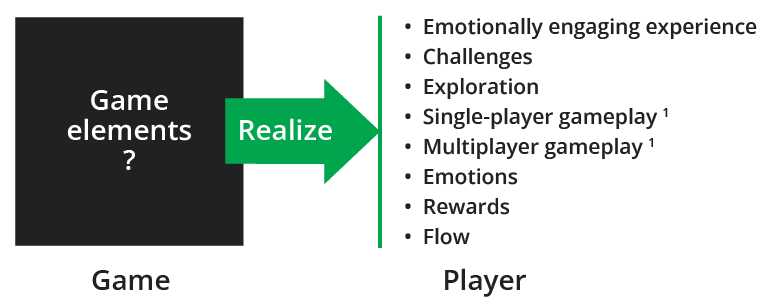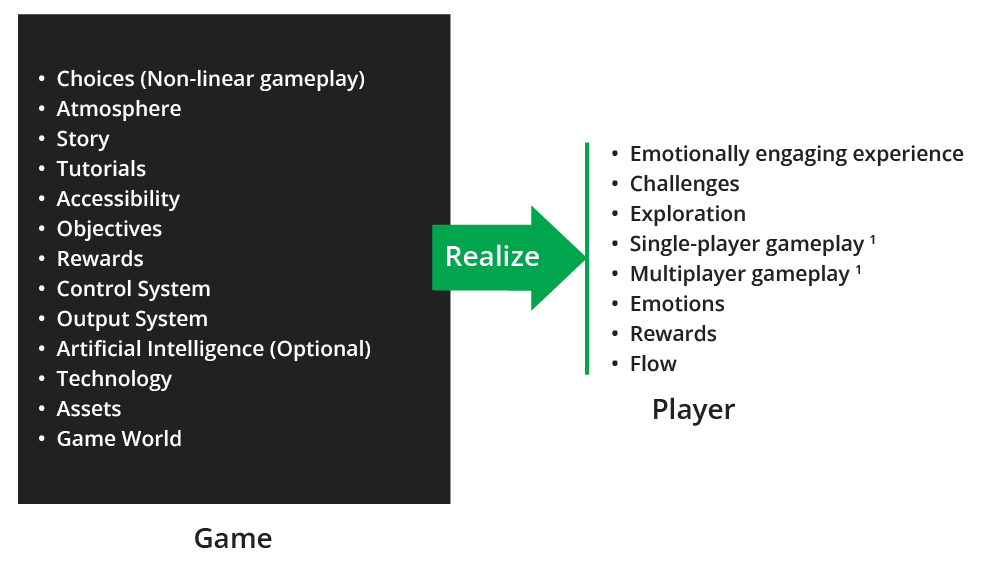Deliver the Right Experience to Players
The primary objective of your game should be to deliver the right experience to its players. But how does one define the “right” experience? To determine this, it is essential first to understand what players seek when engaging with a game.
Motivations to Play Games
In the chapter Key Incentives for Playing Games, you will find an in-depth exploration of player motivations. These motivations are visually summarized in the accompanying figure and are fulfilled through specific game elements, which we will discover later.
On the right side of the figure, you will see what a typical game is expected to offer its players.
1 – Players typically expect either a single-player or multiplayer experience. In many games, both are incorporated.
Understanding the moments when players are emotionally engaged can help you identify the specific game elements that must work in harmony to create the right experience.
Game Elements
Creating an emotionally engaging game can be challenging, though it is entirely achievable. The following high-level steps—linked to comprehensive chapters —offer guidance and practical ideas to support this endeavor:
- Understand the key motivations behind why players engage with games.
- Outline the desired player experience in your game.
- Develop a game design document to consolidate your creative vision and mechanics.
- Incorporate meaningful choices throughout gameplay, whether in single-player or multiplayer modes.
- If your audience prefers single-player experiences, develop a compelling and immersive story.
- Craft the atmosphere of your game world to elicit desired emotional responses.
- Allow players to improve their skills gradually while being forgiving of mistakes.
- Present fair challenges that provide a sense of accomplishment upon completion.
- Offer meaningful rewards to reinforce player progression.
- Ensure your control scheme is intuitive and easy to understand.
- Provide players with clear, responsive feedback.
- Create a game world so immersive that players are reluctant to leave.
- Continuously refine the game experience to maintain a state of flow.
- Release your game only when you are confident that players will find enjoyment in what you have created.
Using these principles, you can form a general list of essential game elements to consider throughout your development process. The diagram below illustrates this relationship.
A list of game elements (left) required to meet player expectations (right).
1 – Every game must include either single-player or multiplayer gameplay, with some games offering both.
As this suggests, relying exclusively on high-quality graphics, music, or sound design (output system) is insufficient if the gameplay or story is subpar. While players expect a certain level of visual and audio polish, your game does not need to match AAA standards. More importantly, you must decide whether your game will focus on single-player, multiplayer, or a combination of both. Finally, it is critical to ensure balance among all game elements—no single aspect should hinder the overall player experience.
Listen to Your Target Audience
Your target audience includes potential players who may be drawn to your game because of its narrative, setting, theme, genre, or core gameplay activities. Once you have identified what players are most interested in experiencing, you can begin developing your game while keeping those insights in mind. However, it is important to understand that these player preferences are suggestions rather than mandatory requirements. You must evaluate which of these desires align with the overall vision and scope of your game.
Bear in mind that most players are not familiar with the intricacies of game development. Therefore, the responsibility falls on you, the developer, to make the final decisions about what to include or exclude from the game.
If you invest sufficient time in listening to your audience, many design uncertainties can be resolved. This engagement will also help you realize that it is virtually impossible to meet the expectations of every player. This is entirely normal and should not be a cause for concern.


